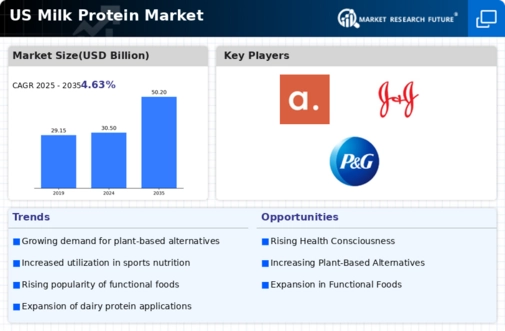Health Consciousness Among Consumers
The increasing awareness of health and wellness among consumers appears to be a primary driver for the milk protein market. As individuals prioritize nutrition, the demand for protein-rich foods has surged. According to recent data, the protein consumption in the US has risen by approximately 20% over the past five years. This trend indicates a shift towards healthier dietary choices, with milk protein being favored for its high biological value and essential amino acids. The milk protein market is likely to benefit from this growing health consciousness, as consumers seek products that support muscle maintenance and overall well-being. Furthermore, the rise of fitness culture and the popularity of protein supplements contribute to the sustained interest in milk protein, suggesting a robust market potential in the coming years.
Growth of the Sports Nutrition Sector
The expansion of the sports nutrition sector is significantly influencing the milk protein market. With an increasing number of individuals engaging in fitness activities, the demand for protein supplements and functional foods has escalated. The sports nutrition market in the US is projected to reach $45 billion by 2026, indicating a substantial opportunity for milk protein products. Athletes and fitness enthusiasts often prefer milk protein due to its ability to aid muscle recovery and enhance performance. This trend suggests that the milk protein market could see a surge in product innovation tailored to this demographic, including ready-to-drink protein shakes and bars. As the sports nutrition sector continues to grow, the milk protein market is likely to capitalize on this momentum, potentially leading to increased sales and market share.
Rising Popularity of Dairy Alternatives
The milk protein market is experiencing a notable impact from the rising popularity of dairy alternatives. As consumers explore plant-based diets, there is a growing interest in products that combine both dairy and plant proteins. This trend indicates a potential shift in consumer preferences, where hybrid products may gain traction. The dairy alternatives market in the US is expected to grow at a CAGR of 10% over the next five years, which could influence the milk protein market. Companies may need to adapt their offerings to include innovative formulations that appeal to both traditional dairy consumers and those seeking plant-based options. This evolving landscape suggests that the milk protein market must remain agile to meet changing consumer demands while maintaining its core offerings.
Increased Focus on Sustainable Practices
The increased focus on sustainable practices within the dairy industry is emerging as a significant driver for the milk protein market. Consumers are becoming more environmentally conscious, prompting companies to adopt sustainable sourcing and production methods. The dairy sector is responding by implementing practices that reduce carbon footprints and enhance animal welfare. This shift towards sustainability is likely to resonate with consumers, as studies indicate that 70% of shoppers prefer brands that demonstrate a commitment to environmental responsibility. The milk protein market could see a positive impact from this trend, as brands that prioritize sustainability may attract a loyal customer base. Furthermore, as regulatory pressures increase, companies that proactively adopt sustainable practices may gain a competitive edge in the market.
Technological Advancements in Dairy Processing
Technological advancements in dairy processing are playing a crucial role in shaping the milk protein market. Innovations in extraction and purification techniques have enhanced the quality and functionality of milk proteins, making them more appealing to manufacturers. For instance, membrane filtration technology allows for the production of high-concentration milk protein isolates, which are increasingly used in various food applications. The milk protein market is likely to benefit from these advancements, as they enable the development of new products with improved nutritional profiles. Additionally, these technologies can lead to cost efficiencies in production, potentially lowering prices for consumers. As the industry embraces these innovations, the market for milk protein may expand, offering a wider range of products to meet diverse consumer needs.














Leave a Comment